Monet paintings around the world
“A journey around the world through the works of Monet: 15 extraordinary paintings by the father of Impressionism, from Poppies to Water Lilies!
Claude Monet began dedicating his life to art at a young age, quickly defining an immediately recognizable personal style. In fact, the term “impressionist” was actually created for Monet himself in 1873, when the artist exhibited some of his works in Paris, together with friends Renoir, Sisley, Pissaro, Degas and Prins, and befits the French painter more than anyone else. A reserved and solitary (and sometimes bad-tempered) individual Monet quickly became an icon of an entire artistic movement, which was based on a few fundamental concepts: The painting, wherever possible, had to depict real life, and given that nature was supposed to be the painter’s primary source of inspiration, the work had to be painted “en plein air” (outdoors). This was the only way to instantly transfer the visual impression created by an atmosphere in a precise, determined moment, to the canvas.
Monet’s focus on light-and in particular to the reflection of light on water and on surfaces in general-was so meticulous and incessant that he came to be defined as “a scientist of color“. However, more than a scientist, Monet was first and foremost a poet, demonstrated by this small selection of the painter’s works.
### 1. Woman in the Garden, Sainte-Adresse
Our journey begins in the magnificent galleries of The State Hermitage Museum in St Petersburg with Woman in the Garden, Sainte-Adresse, one of Monet’s first impressionist works. Painted in 1867, it is one of his most successful initial pieces created entirely en plein air. Its strength lies primarily in his striking depiction of the midday sun, the blighting glow of which is enhanced by the pure white dress worn by the woman depicted in the left-hand side of the painting, but also in the balance of the composition, which, in Monet’s works, always plays a prominent role.

Woman in the Garden, Sainte-Adresse – By Claude Monet – http://www.arthermitage.org/Claude-Monet/Woman-in-the-Garden-Sainte-Adresse.html, Public Domain, https://commons.wikimedia.org/w/index.php?curid=155850
### 2. The Portal, Morning Fog
Between 1890 and 1895, Monet focused even more rigorously on his study of light and on depicting its effects through the medium of paint. During this period, the artist chose a few specific themes, which he used as a basis for several series of works, each one focusing exclusively on the recreation of atmospheric conditions, times of the day, and sometimes, the seasons. The Rouen Cathedral series is perhaps one of the most significant products of this focus: over and over again, Monet depicts the facade of Rouen Cathedral, the intricate architectural details of which create elaborate light and shadow patterns, making it a more-than-suitable subject for his project. The Portal, Morning Fog, exhibited at the Museum Folkwang in Essen, Germany, is just one of the many canvases dedicated to the cathedral, which today enrich both public and private collections in every corner of the globe.
### 3. Poppies
France was and still is Monet’s homeland: The museums in Paris are undoubtedly home to the highest number of works produced by the father of Impressionism. In this sense, the collection at the Musée d’Orsay is most likely the richest. Amongst the works exhibited here isPoppy Field, one of the most famous paintings in the world, in which Monet depicts a large field of poppies in Argenteuil, a commune in the north of Paris where the painter moved with his family in 1871. The vibrant atmosphere of a sunny summer’s afternoon bursts out from the canvas, dominated by a sensational landscape in which the subjects are not portrayed in detail but are depicted as mere silhouettes, blending into the surrounding nature.
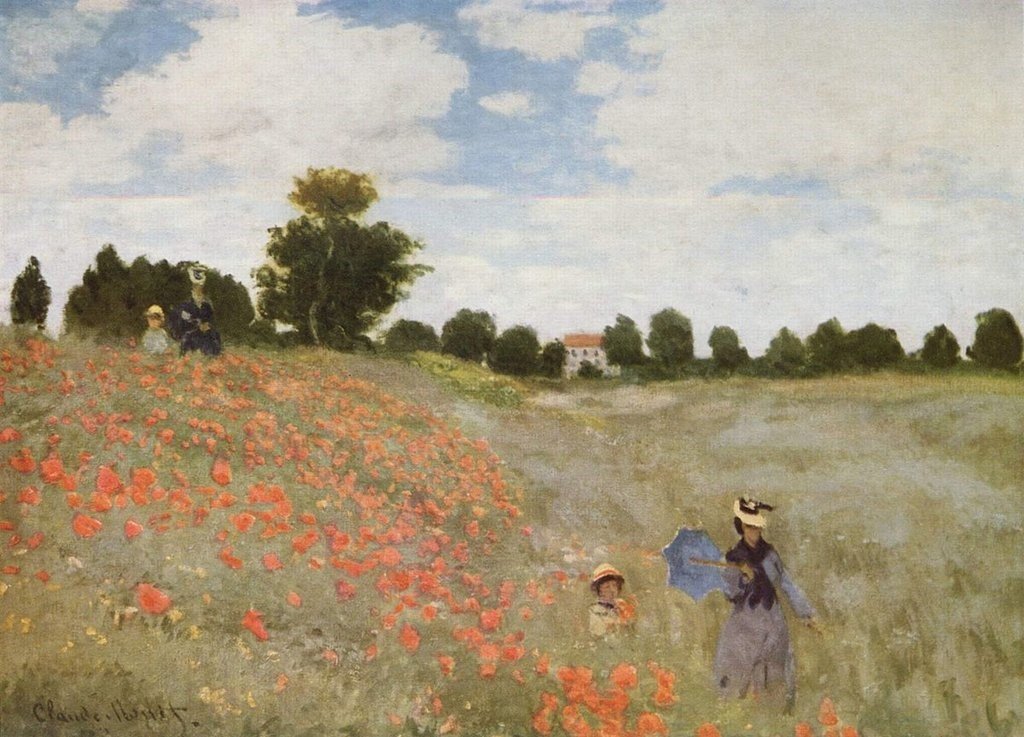
Poppy Field – Claude Monet – The Yorck Project: 10.000 Meisterwerke der Malerei. DVD-ROM, 2002. ISBN 3936122202. Distributed by DIRECTMEDIA Publishing GmbH., Public domain, https://commons.wikimedia.org/w/index.php?curid=155867
### 4. Camille on Her Deathbed
It may not be one of Monet’s most famous, however it is undeniable that this painting, once again now exhibited at the Musée d’Orsay, captures something extraordinary. Claude Monet wanted to admire his wife Camille one last time before she passed away after a 32-year-long illness, and while it is true that there is also something rather macabre about it, the painter’s desire to cement his last image of her on canvas was, for him, something natural and instinctive. What makes the work so disconcerting are the swirls of purple, gray and blue, swamping the woman’s features. In this particular work, Monet once again focuses on color: This time, not in portraying the natural beauty of a landscape, but in depicting death and human pain.
### 5. Luncheon on the Grass
The title of this work may remind you of the famous pre-impressionist masterpiece by Édouard Manet, by which it was indeed inspired. After spending the Easter holidays in Chailly de Refusés with friends Bazille, Sisley and Renoir, Monet decided to paint a large work illustrating a picnic in the forest of Fontainebleau. This project was particularly significant: Originally designed as a six-by-four-meter canvas, it was supposed to be in part painted en plein air to represent life-size human figures, intended to outdo Manet’s Luncheon on the Grass with its realist style. However, despite his noble intentions and commitment, Monet never managed to complete the work, of which just one part (of around two-by-two meters) remains today, and is exhibited at the Musée d’Orsay.
### 6. The Magpie
No one in the history of art has ever managed to paint snow like Monet did. In 1867, the painter produced the first series of winter landscapes painted entirely outdoors, including The Magpie, which today is displayed at the Musée d’Orsay. The idea was that painter had to complete the works strictly en plein air, and his taste for solitude, together with his incredible ability to withstand nature’s hardships, allowed Monet to remain faithful to this principle, even during the coldest winter days. The Magpie radiates the silence and glacial stillness of a winter morning, which, through the medium of painting, Monet transforms into an unforgettable visual work of poetry.
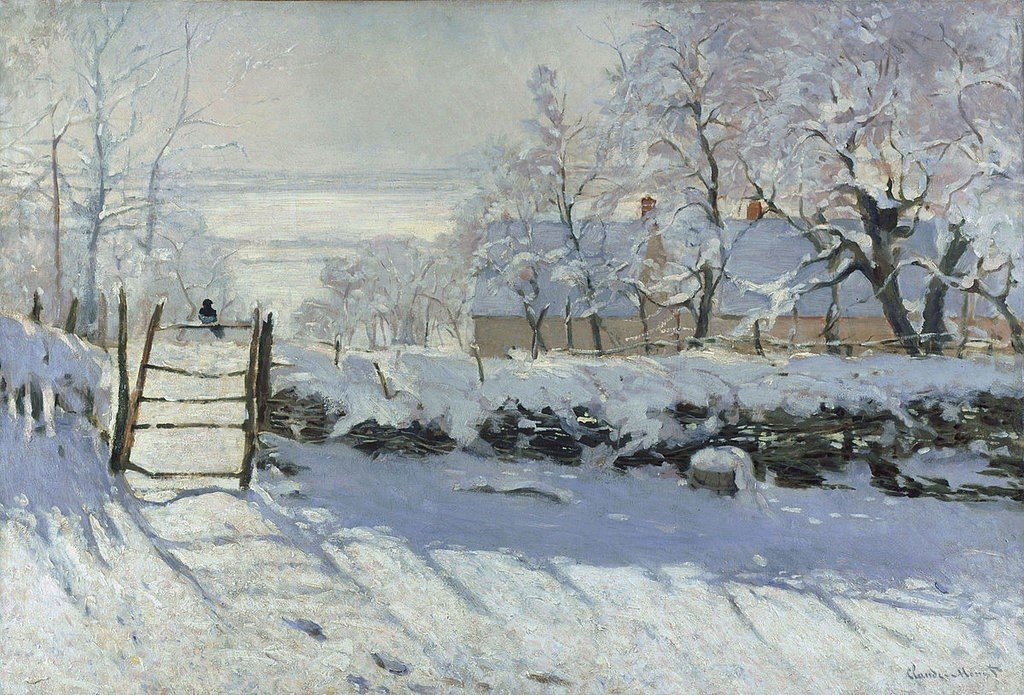
The Magpie – By Claude Monet – rQGnadHwK8lSmg at Google Cultural Institute maximum zoom level, Public Domain, https://commons.wikimedia.org/w/index.php?curid=21856725
### 7. Water Lilies
The theme of water lilies was Monet’s last great obsession, which, inspired by the lake in his garden in Giverny, the painter continued to depict in endless ways for around 26 years. Like his Rouen Cathedral series, Monet’s canvases dedicated to water lilies can be found all over the world. However, one work is widely considered to be the masterpiece of the collection: the incredible Water Lilies at the Musée de l’Orangerie, which Georges Clémenceau commissioned Monet to produce for the museum’s two oval halls. This painting is Monet’s one true artistic testament and perhaps his most successful work, harmoniously combining his desire to produce a large decorative painting with the sincerity of a painting executed en plein air. Painter André Masson actually defined the Orangerie galleries as “the Sistine Chapel of Impressionism“. Could you think of a more fitting title?
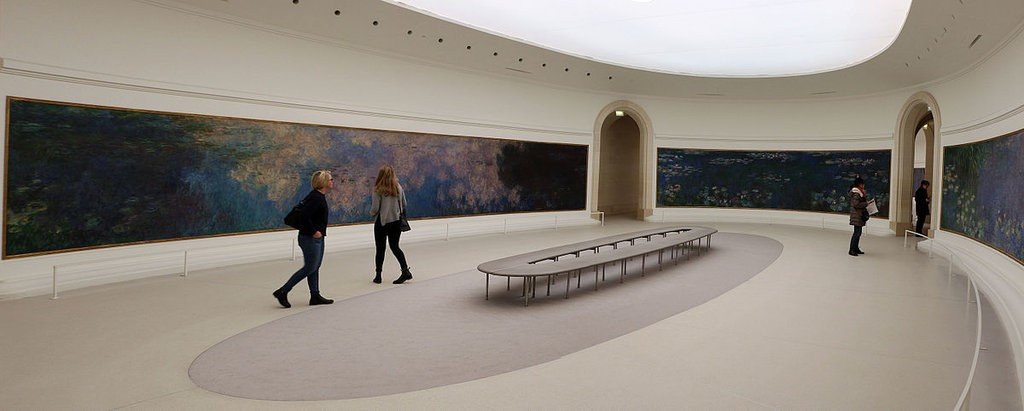
Water Lilies by Monet in the oval hall at the Musée de l’Orangerie – By I, Sailko, CC BY-SA 3.0, https://commons.wikimedia.org/w/index.php?curid=47311155
### 8. Impression, Sunrise
Amongst all the paintings displayed at the exhibition of the Société Anonyme des artistes Peintres, Sculptures et Graveurs (association founded in 1873 by Monet, Renoir, Sisley, Pissarro, Degas and Prins), Impression, Sunrise by Monet was the work that gave its name to what from 1874 onwards would be defined as the impressionist movement. The painting depicts a view over the port of Le Havre at sunrise, surrounded by a landscape veiled in violet hues in which every object appears to lose its true lines and dimensions. Only the sun remains still and distinct, like a shining eye in Monet’s misty sky. The work is displayed at the Marmottan Museum in Paris and elegantly showcases the salient characteristics of the revolutionary school of painting: the scientific focus on the depiction of light, the use of color as a means to create optical effects, the meticulous application of hundreds of tiny strokes, a fixation on reflections, the importance of the painting being created en plein air and the desire to produce something of poetic beauty through direct contact with nature.
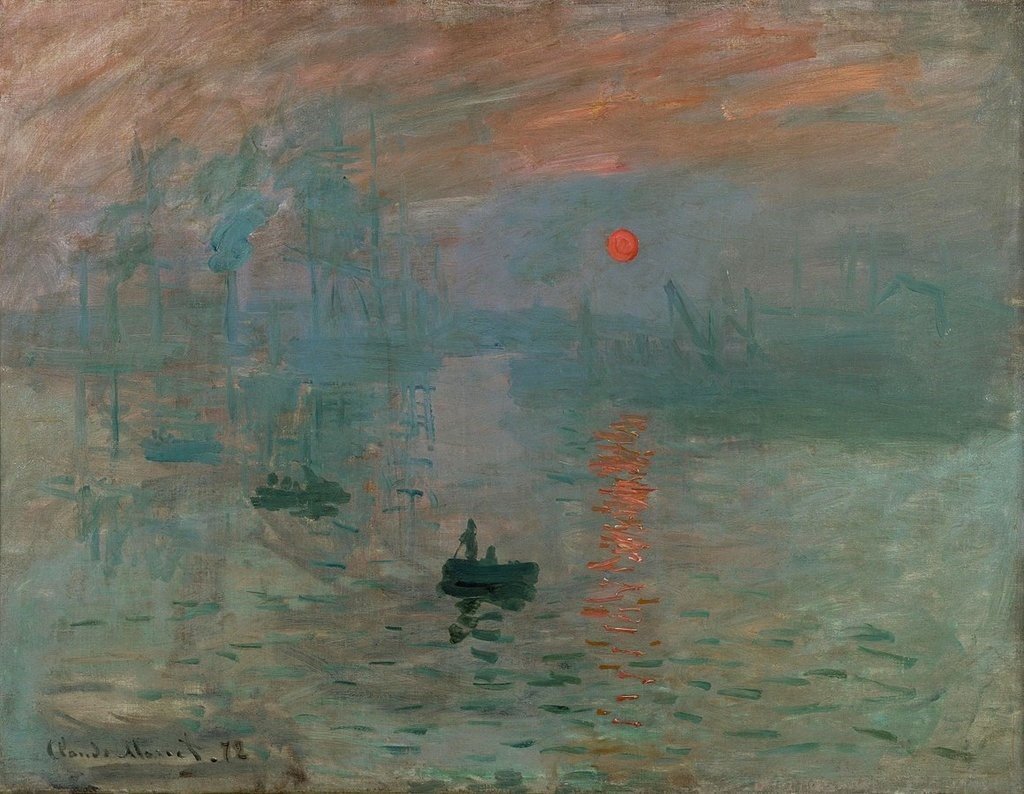
Impression, Sunrise – By Claude Monet – art database, Public domain, https://commons.wikimedia.org/w/index.php?curid=23750619
### 9. La Pointe de la Hève, Sainte-Adresse
The importance of water in Monet’s paintings can already be seen in the marine landscapes he painted in the 1860s, one example of which is La Pointe de la Hève, Sainte-Adresse. Part of the impressionist collection at the National Gallery in London, this painting already showcases Monet’s abilities and distinguishing traits at the age of just twenty-four. The work demonstrates the painter’s observation and compositional skills, as well as his instantly recognizable technique. Within a dim and melancholy natural landscape, short vibrant strokes effortlessly depict the waves-that almost seem to move underneath the little wooden boat-and the beach, an expanse of hundreds of small pebbles that spill over the canvas like a multicolored mosaic.
### 10. La Grenouillère
The Grenouillère was a popular and elite bathing establishment on the Seine, frequented by members of the Parisian bourgeoisie. In 1868, Renoir chose it as the cherished spot for his paintings produced en plein air, shortly joined by Monet a year later. The outcome of this artistic union was the canvas entitled La Grenouillère, now exhibited at the Metropolitan Museum of Art in New York. Like The River (painted in ’67), even though the work includes human figures, Monet’s focus is on the depiction of reflections on the water, using long, fast strokes. Despite the high quality of the end result, Renoir’s Luncheon of the Boating Party would go on to be the most successful work on this subject matter. Monet was destined to move further and further away from the human dimension, fully immersing himself in nature.
### 11. Palazzo Ducale, Venice
Throughout his career, Monet produced many series of paintings. Aside from those depicting Rouen Cathedral, one group of paintings stands out amongst his architectural collection-a set of works portraying the palaces of Venice, which the painter visited between 1908 and 1909. For Monet, Venice was the ultimate impressionist city: stunning architecture and elegant profiles that tower above and reflect on the water … what more could he ask for? At the Brooklyn Museum in New York, you can admire one of his most beautiful works dedicated to this theme.
### 12. Water Lilies and Japanese Bridge
In 1883, Monet and his family moved to Giverny, a small French commune in Normandy. He remained here for the rest of his life, and it was this commune that formed the basis of his impressionist kingdom, constructed from peace and nature. In 1891, by diverting an arm of the river Epte, Monet created a lake with a little Japanese bridge. There are no places in the history of art that have been studied as meticulously as Lake Giverny, depicted from endless angles in countless variations. Amongst these many depictions is the canvas at the Princeton University Art Museum, which, together with Water Lilies at the Musée de l’Orangerie, is one of the painter’s most well-known works.
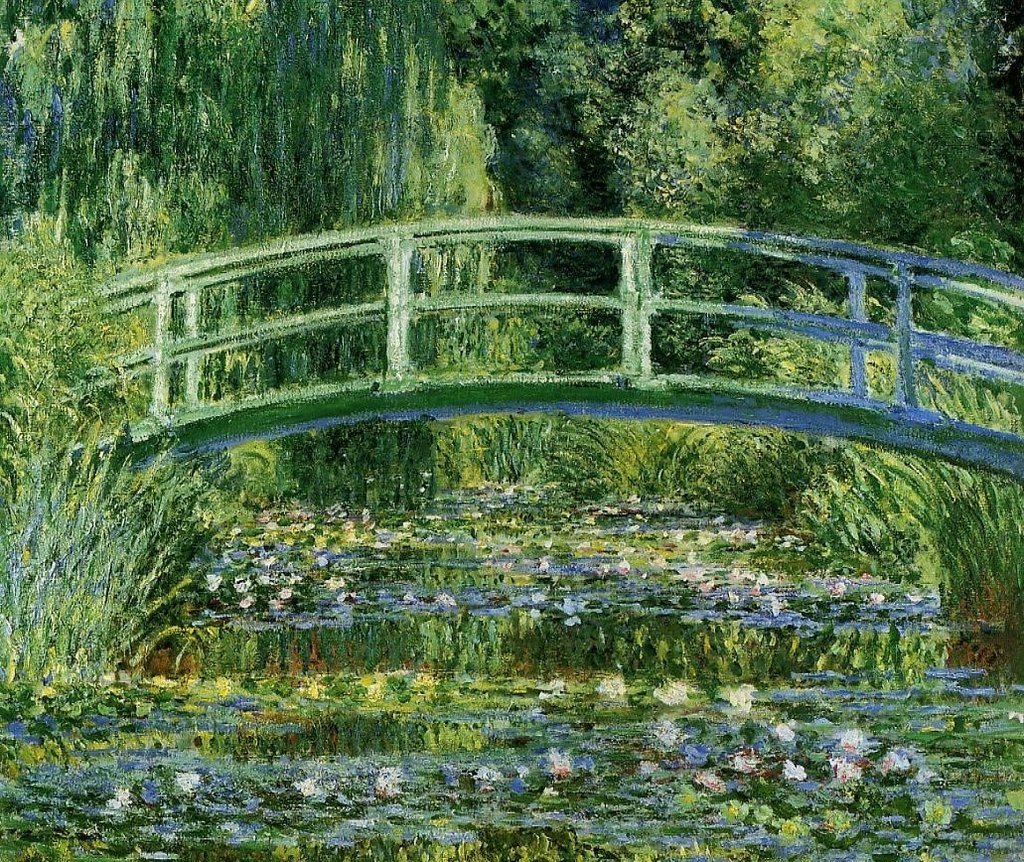
Water Lilies and Japanese Bridge – By Claude Monet – the-athenaeum.org , Public Domain, https://commons.wikimedia.org/w/index.php?curid=5749305
### 13. Houses of Parliament, Sunset
Like Venice, London was also a source of charm and fascination for Monet, and was where he chose to spend every winter between 1899 and 1901. It was in this period that the artist produced his series dedicated to the Thames, which comprises at least 100 different views of the river (some overlooking Waterloo Bridge, others depicting the Houses of Parliament from St Thomas’ Hospital). The National Gallery of Art in Washington holds several works by Monet. As well as his cathedrals, water lilies and various natural landscapes, you can also admire the painter’s stunning Houses of Parliament, Sunset, one of the most beautiful canvases dedicated to London’s iconic architecture.
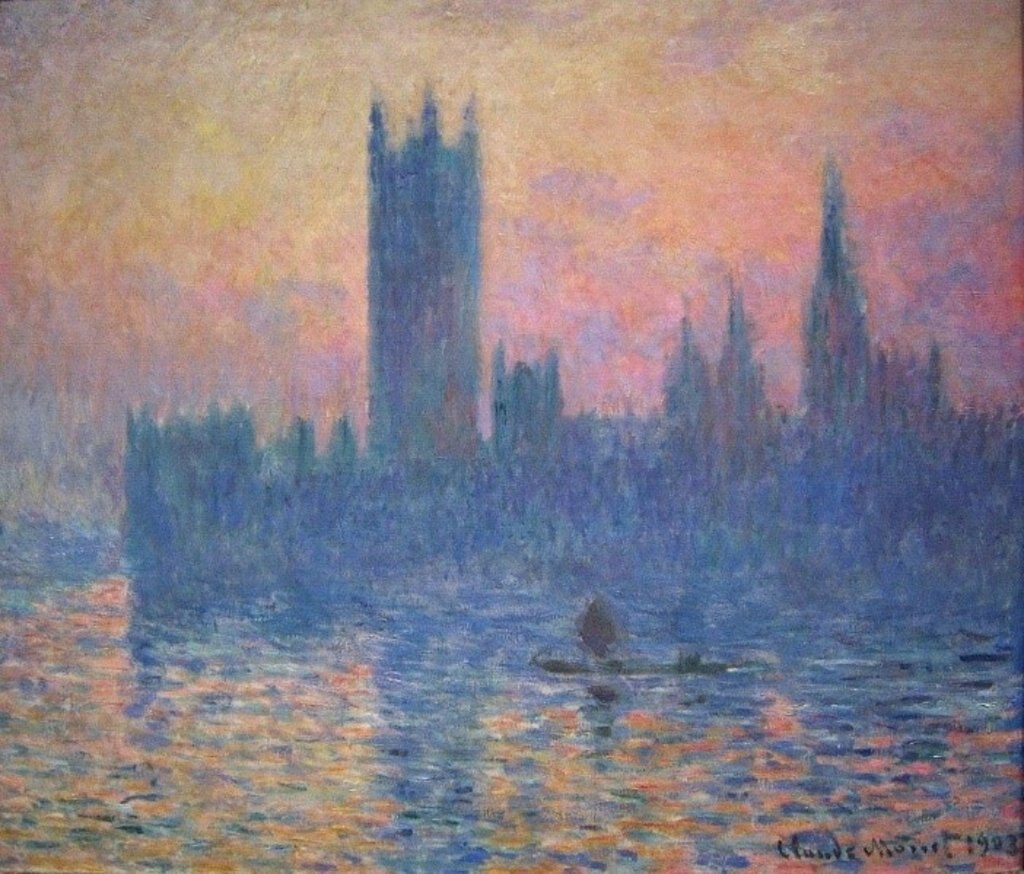
Houses of Parliament, Sunset – By Claude Monet – Digital photo by User:Postdlf, Public Domain, https://commons.wikimedia.org/w/index.php?curid=11872903
### 14. The River
Painted in 1868 and currently exhibited at the Art Institute of Chicago, The River represents a significant work in Monet’s career. Here, the theme of water, which Monet had already previously explored with his marine landscapes, undergoes a distinct transformation, with the reflections becoming the protagonist of the painting. Every single brush stroke on this canvas contributes to the painter’s flawless depiction of the reflections on the water, which, characterized by an undefined, fleeting nature, give the image a sense of spontaneity. Monet’s first true homage to the instantaneousness of perception.
### 15. Stacks of Wheat (Sunset, Snow Effect)
Like Monet’s group of works depicting Rouen Cathedral, his Haystacks series is also considered by some a genuine scientific experiment. This series also comprises a plethora of canvases (including the one exhibited at the Art Institute of Chicago), offering a myriad of different depictions, portraying haystacks in different lighting, at different times of the day, and during different periods of the year. The simplicity of his subjects’ form allowed Monet to focus on the modulation of light and the effects that this creates on surfaces more meticulously than ever. Unlike the series dedicated to architecture, Haystacks is considered to be one of the most successful results of Monet’s complete and intimate connection with nature.
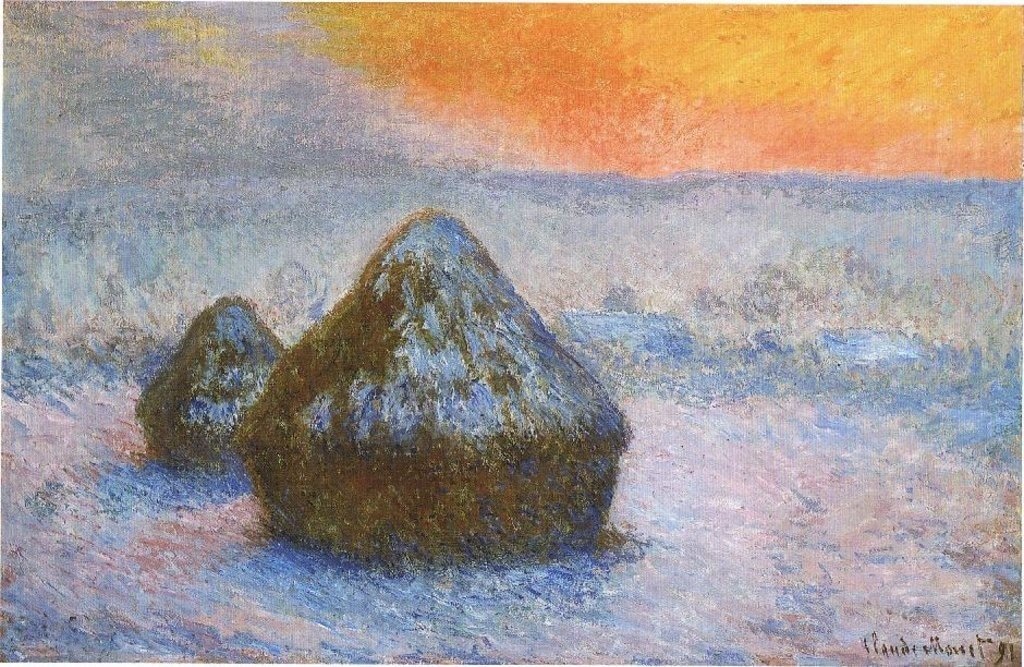
Stacks of Wheat (Sunset, Snow Effect) – By Claude Monet – Scanned from Stuckey, Charles F., Claude Monet 1840-1926, 1995, co-published by The Art Institute of Chicago and Thames and Hudson., Public domain, https://commons.wikimedia.org/w/index.php?curid=4376073
Cover photo: Monet, Water Lilies and Clouds – By I, Sailko, CC BY-SA 3.0, https://commons.wikimedia.org/w/index.php?curid=47311181“
More Articles With Art
Discover the very best museums and galleries through virtual tours. From London to New York, explore these online museums without leaving your home!
Find everything you need for a fun visit to the York Art Gallery with this comprehensive visitor’s guide.
Discover the top art galleries in London to experience some history and culture on your holiday.
Discover the top art galleries in Manchester to experience culture and history on your next holiday.
Visiting the spas and Georgian buildings of Bath? Check out our visitor’s guide to the Fashion Museum.